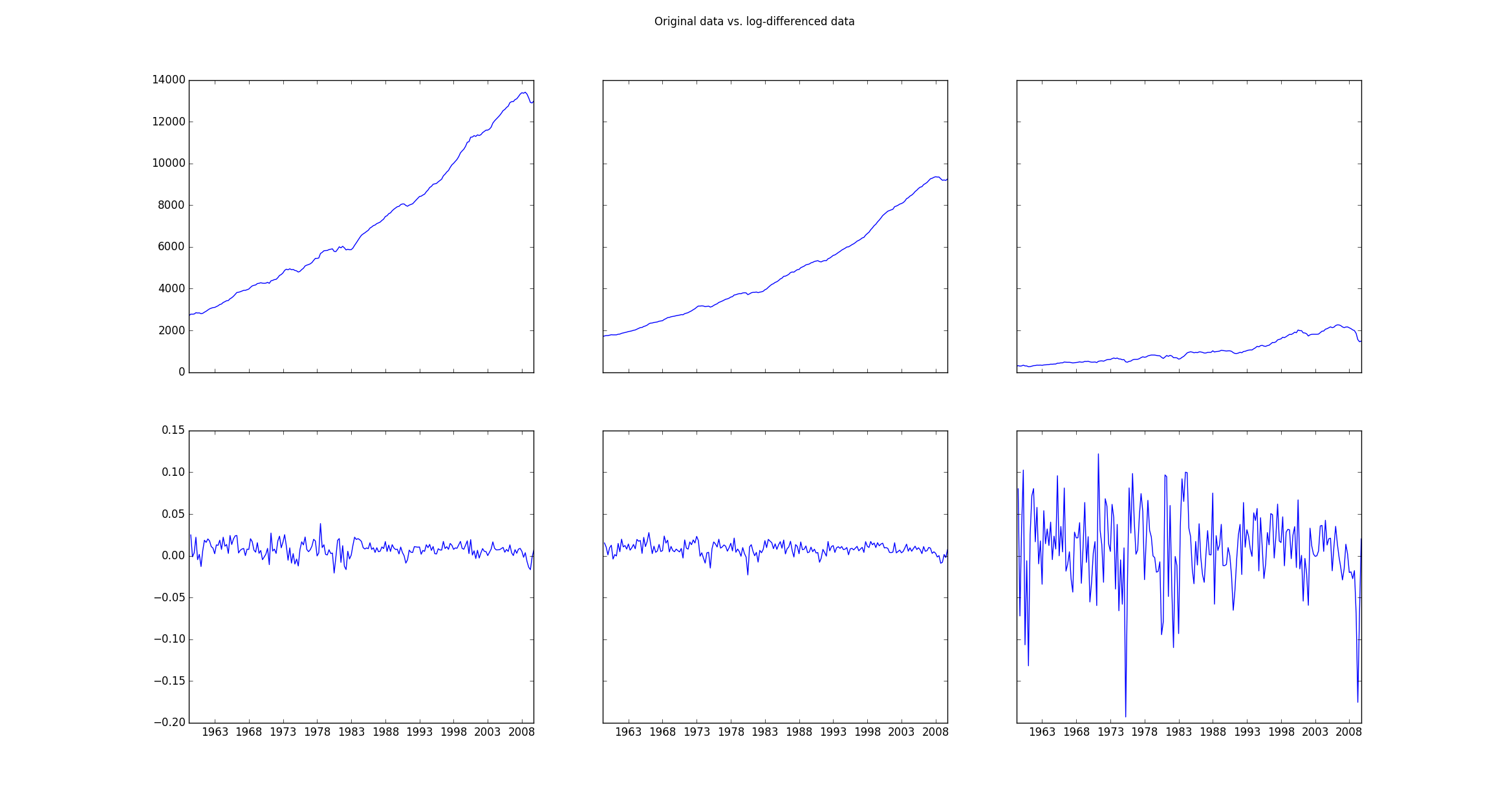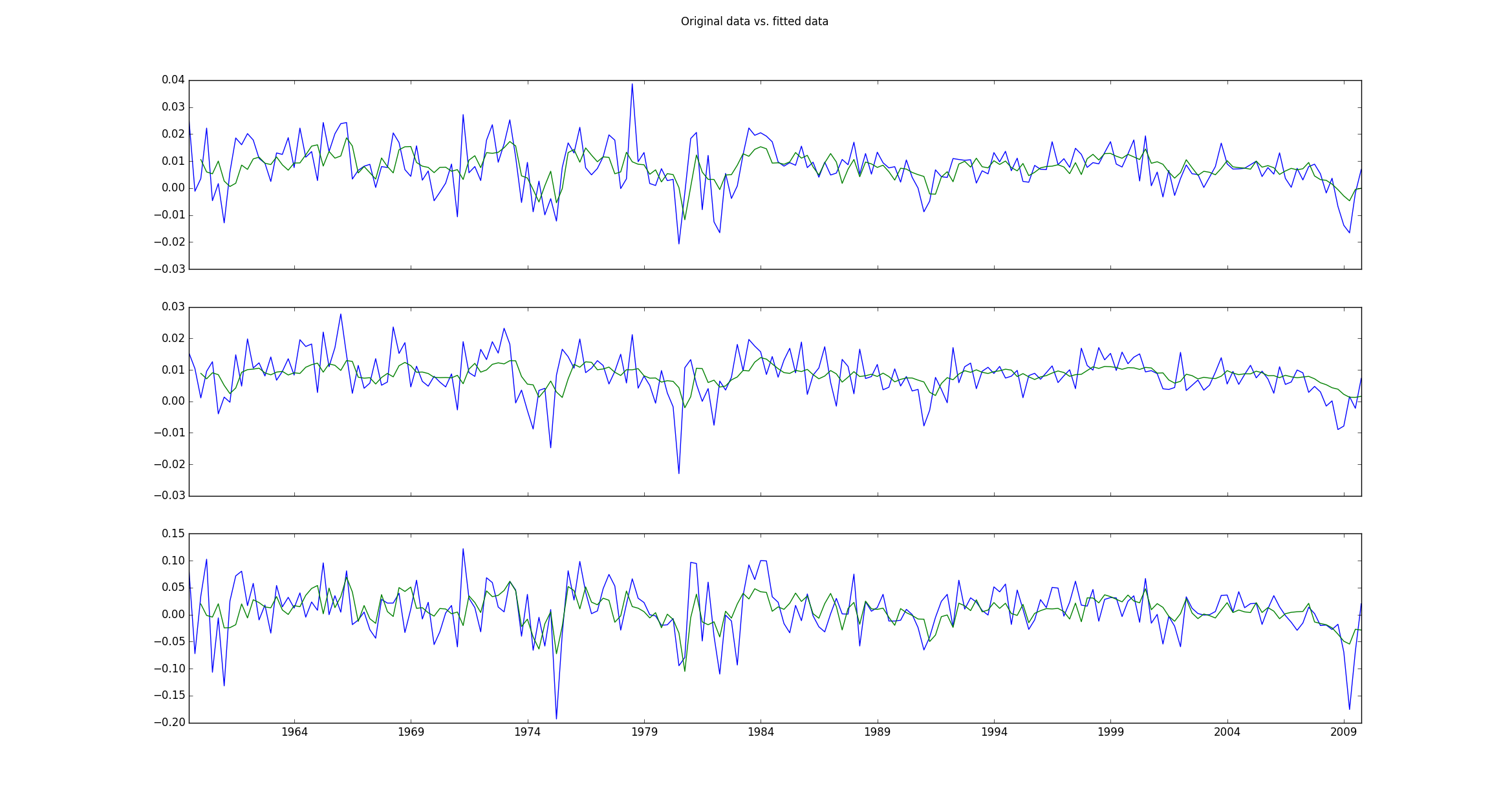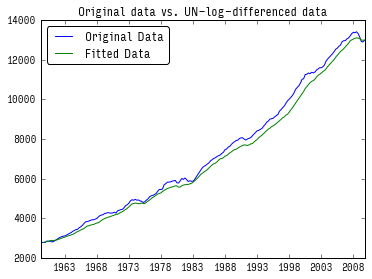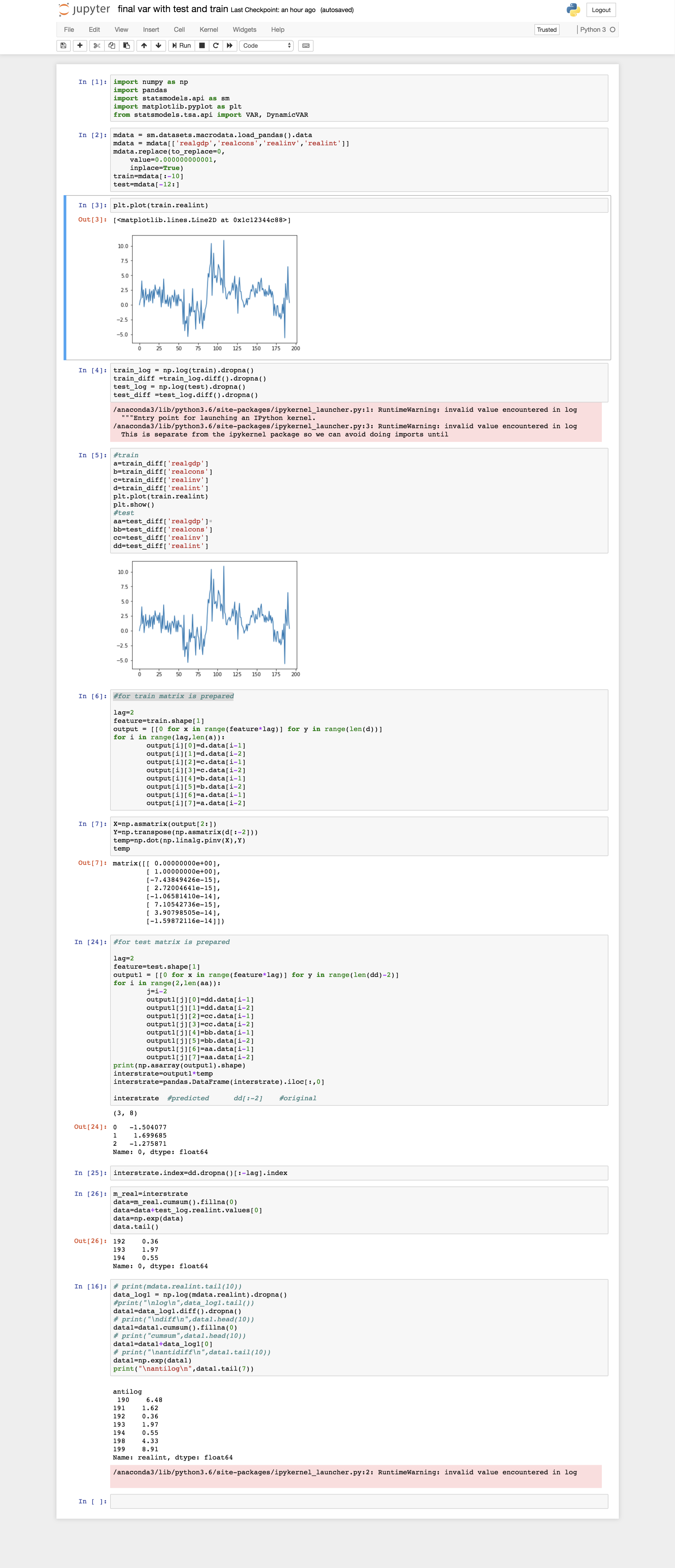I followed the statsmodel tutorial on VAR models and have a question about the results I obtain (my entire code can be found at the end of this post).
The original data (stored in mdata)is clearly non-stationary and therefore needs to be transformed which is done using the line:
data = np.log(mdata).diff().dropna()
If one then plots the original data (mdata) and the transformed data (data) the plot looks as follows:
Then one fits the log-differenced data using
model = VAR(data)
results = model.fit(2)
If I then plot the original log-differenced data vs. the fitted values, I get a plot like this:
My question is how I can get the same plot but for the original data which are not log-differenced. How can I apply the parameters determined by the fitting values to the these original data? Is there a way to transform the fitted log-differenced data back to the original data using the parameters I obtained and if so, how can this be accomplished?
Here is my entire code and the output I obtain:
import pandas
import statsmodels as sm
from statsmodels.tsa.api import VAR
from statsmodels.tsa.base.datetools import dates_from_str
from statsmodels.tsa.stattools import adfuller
import numpy as np
import matplotlib.pyplot as plt
mdata = sm.datasets.macrodata.load_pandas().data
dates = mdata[['year', 'quarter']].astype(int).astype(str)
quarterly = dates["year"] + "Q" + dates["quarter"]
quarterly = dates_from_str(quarterly)
mdata = mdata[['realgdp', 'realcons', 'realinv']]
mdata.index = pandas.DatetimeIndex(quarterly)
data = np.log(mdata).diff().dropna()
f, ((ax1, ax2, ax3), (ax4, ax5, ax6)) = plt.subplots(2, 3, sharex='col', sharey='row')
ax1.plot(mdata.index, mdata['realgdp'])
ax2.plot(mdata.index, mdata['realcons'])
ax3.plot(mdata.index, mdata['realinv'])
ax4.plot(data.index, data['realgdp'])
ax5.plot(data.index, data['realcons'])
ax6.plot(data.index, data['realinv'])
f.suptitle('Original data vs. log-differenced data ')
plt.show()
print adfuller(mdata['realgdp'])
print adfuller(data['realgdp'])
# make a VAR model
model = VAR(data)
results = model.fit(2)
print results.summary()
# results.plot()
# plt.show()
f, axarr = plt.subplots(3, sharex=True)
axarr[0].plot(data.index, data['realgdp'])
axarr[0].plot(results.fittedvalues.index, results.fittedvalues['realgdp'])
axarr[1].plot(data.index, data['realcons'])
axarr[1].plot(results.fittedvalues.index, results.fittedvalues['realcons'])
axarr[2].plot(data.index, data['realinv'])
axarr[2].plot(results.fittedvalues.index, results.fittedvalues['realinv'])
f.suptitle('Original data vs. fitted data ')
plt.show()
which gives the following output:
(1.7504627967647102, 0.99824553723350318, 12, 190, {'5%': -2.8768752281673717, '1%': -3.4652439354133255, '10%': -2.5749446537396121}, 2034.5171236683821)
(-6.9728713472162127, 8.5750958448994759e-10, 1, 200, {'5%': -2.876102355, '1%': -3.4634760791249999, '10%': -2.574532225}, -1261.4401395993809)
Summary of Regression Results
==================================
Model: VAR
Method: OLS
Date: Wed, 09, Mar, 2016
Time: 15:08:07
--------------------------------------------------------------------
No. of Equations: 3.00000 BIC: -27.5830
Nobs: 200.000 HQIC: -27.7892
Log likelihood: 1962.57 FPE: 7.42129e-13
AIC: -27.9293 Det(Omega_mle): 6.69358e-13
--------------------------------------------------------------------
Results for equation realgdp
==============================================================================
coefficient std. error t-stat prob
------------------------------------------------------------------------------
const 0.001527 0.001119 1.365 0.174
L1.realgdp -0.279435 0.169663 -1.647 0.101
L1.realcons 0.675016 0.131285 5.142 0.000
L1.realinv 0.033219 0.026194 1.268 0.206
L2.realgdp 0.008221 0.173522 0.047 0.962
L2.realcons 0.290458 0.145904 1.991 0.048
L2.realinv -0.007321 0.025786 -0.284 0.777
==============================================================================
Results for equation realcons
==============================================================================
coefficient std. error t-stat prob
------------------------------------------------------------------------------
const 0.005460 0.000969 5.634 0.000
L1.realgdp -0.100468 0.146924 -0.684 0.495
L1.realcons 0.268640 0.113690 2.363 0.019
L1.realinv 0.025739 0.022683 1.135 0.258
L2.realgdp -0.123174 0.150267 -0.820 0.413
L2.realcons 0.232499 0.126350 1.840 0.067
L2.realinv 0.023504 0.022330 1.053 0.294
==============================================================================
Results for equation realinv
==============================================================================
coefficient std. error t-stat prob
------------------------------------------------------------------------------
const -0.023903 0.005863 -4.077 0.000
L1.realgdp -1.970974 0.888892 -2.217 0.028
L1.realcons 4.414162 0.687825 6.418 0.000
L1.realinv 0.225479 0.137234 1.643 0.102
L2.realgdp 0.380786 0.909114 0.419 0.676
L2.realcons 0.800281 0.764416 1.047 0.296
L2.realinv -0.124079 0.135098 -0.918 0.360
==============================================================================
Correlation matrix of residuals
realgdp realcons realinv
realgdp 1.000000 0.603316 0.750722
realcons 0.603316 1.000000 0.131951
realinv 0.750722 0.131951 1.000000





realgdpI obtainL1.realcons=0.675016andL1.realgdp=-0.279435. What exactly does that tell me? Can one interpret these coefficients somehow as something similar like correlation coefficients? How would one express this relationship verbally? – Volpe